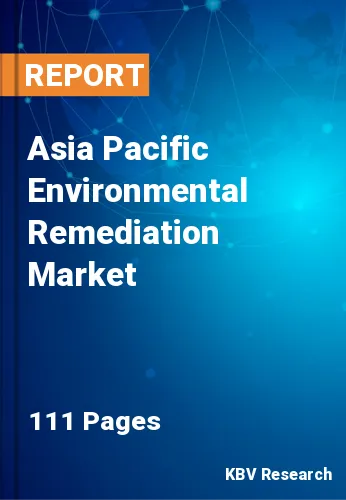The Asia Pacific Environmental Remediation Market would witness market growth of 8.7% CAGR during the forecast period (2022-2028).
Managers of the natural sciences supervise the scientific experts participating in a remediation effort. Due to the diversity of technology involved in the cleanup, several scientists from various fields may be involved in these initiatives. These scientists are supervised and coordinated by managers in the natural sciences. Specialists in public relations are responsible for informing the public about remediation efforts. This is especially critical if an oil spill or other disaster has contaminated a region. Public relations professionals synthesize information provided by other project members and deliver it to the public in a simple manner.
Nanoremediation is the use of nanoscale reactive agents to break down or immobilize pollutants. In soil or groundwater nanoremediation, nanoparticles are introduced to the contamination either in situ injection or pump-and-treat. The nanoparticles then break down organic pollutants via redox reactions or adsorb and immobilize metals including lead and arsenic.
This method has been utilized mostly for groundwater remediation in business contexts, with investigations into wastewater treatment. Also, being investigated is applying nanoparticles to the remediation of soil and gases. Because of their high surface area per unit mass, nanoparticles are extremely reactive, and due to their reactivity, nanomaterials may react with target pollutants faster than bigger particles.
In this region, there are about 2.1 billion urban dwellers, and by 2050, the majority of them are projected to reside in cities. These predictions illustrate the necessity for water management and the market growth potential of the region. Moreover, Asian nations like Thailand, Malaysia, and Vietnam are actively pushing the construction of water systems, which contributes to the expansion of the regional market. In addition, the proliferation of smart city initiatives in the region would generate new growth prospects for local market merchants.
The China market dominated the Asia Pacific Environmental Remediation Market by Country in 2021; thereby, achieving a market value of $13.7 billion by 2028. The Japan market is registering a CAGR of 8% during (2022 - 2028). Additionally, The India market would showcase a CAGR of 9.4% during (2022 - 2028).
Based on Site Type, the market is segmented into Private and Public. Based on Technology, the market is segmented into Bioremediation, Soil Washing, Phytoremediation, Excavation, Permeable Reactive Barriers, Chemical Treatment, Electrokinetic Remediation, Pump & Treat, Soil Vapor Extraction, Thermal Treatment, and In-situ Grouting & In-situ Vitrification. Based on Environment Medium, the market is segmented into Soil and Groundwater. Based on Application, the market is segmented into Oil & Gas, Manufacturing, Industrial, & Chemical Production/Processing, Automotive, Construction & Land Development, Agriculture, Mining & Forestry, Landfills & Waste Disposal Sites, and Others. Based on countries, the market is segmented into China, Japan, India, South Korea, Singapore, Malaysia, and Rest of Asia Pacific.
Free Valuable Insights: The Worldwide Environmental Remediation Market is Projected to reach USD 169.6 Billion by 2028, at a CAGR of 8.1%
The market research report covers the analysis of key stake holders of the market. Key companies profiled in the report include WSP Global, Inc. (Golder Associates), Clean Harbors, Inc., AECOM Corporation, Stantec, Inc., HDR, Inc., Tetra Tech, Inc., Jacobs Engineering Group Inc., DEME NV and BRISEA Group, Inc.
By Site Type
By Technology
By Environment Medium
By Application
By Country
Our team of dedicated experts can provide you with attractive expansion opportunities for your business.

